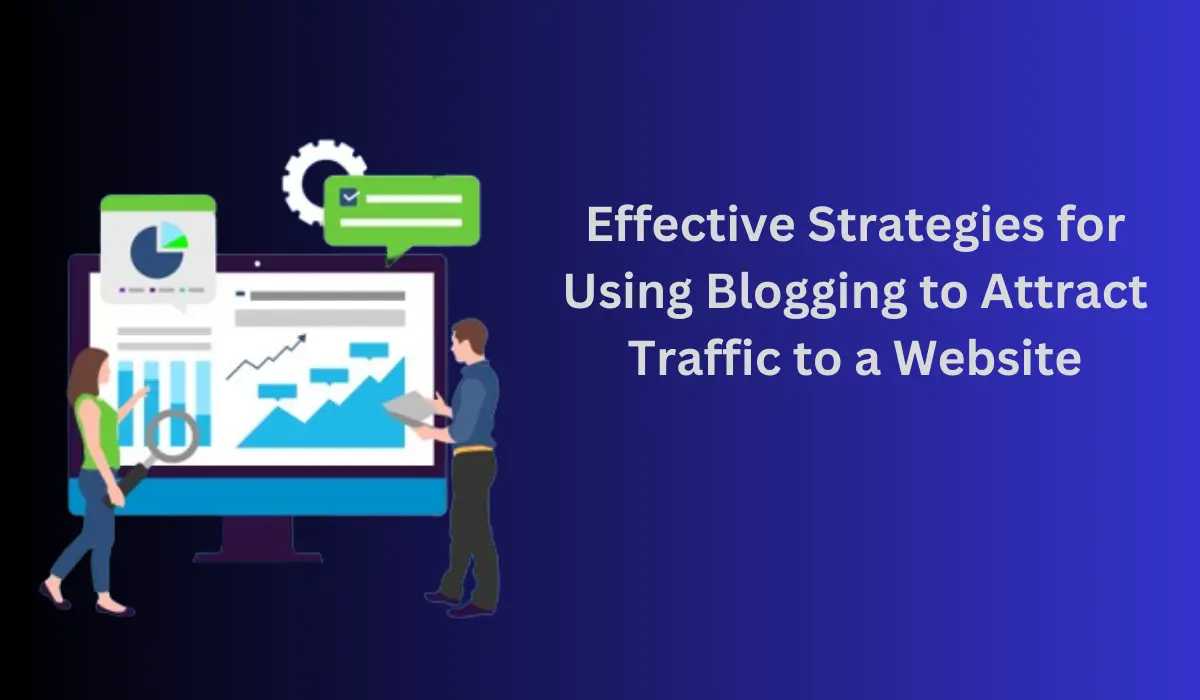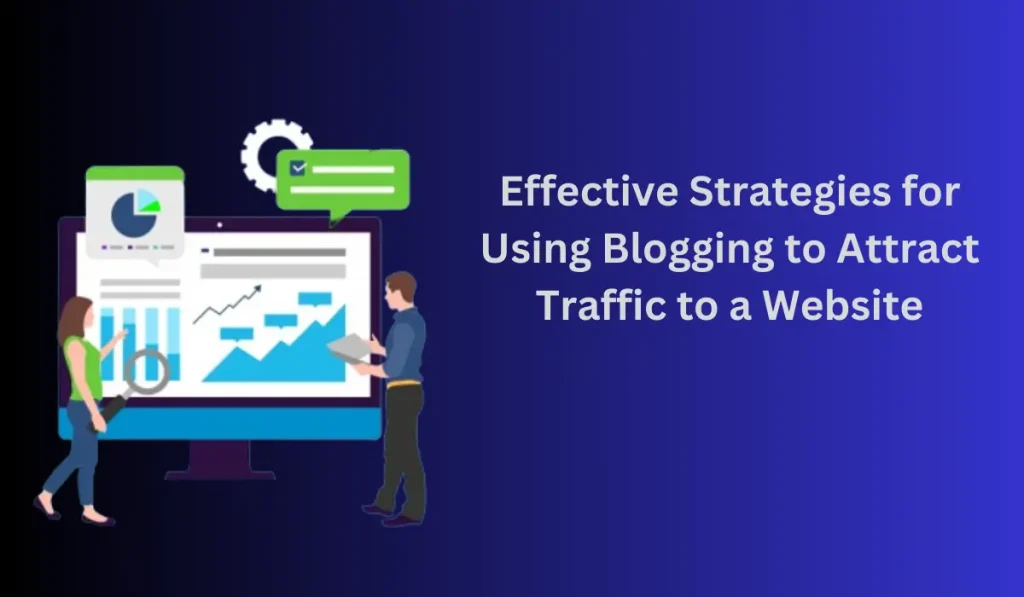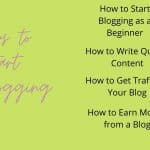In the digital age, blogging has emerged as a powerful tool for driving traffic to websites. A well-executed blog can significantly enhance your online presence, establish authority in your niche, and engage with your audience effectively. Here are some effective strategies for using blogging to attract traffic to your website:
1. Create High-Quality, Relevant Content
Creating high-quality, relevant content is the cornerstone of any successful blog. This type of content attracts readers and encourages them to stay on your site, engage with your material, and share it with others. Here are key strategies to ensure your blog content meets these criteria:
Understand Your Audience
Research Your Audience: Use tools like Google Analytics, social media insights, and surveys to understand who your readers are, what interests them, and what problems they need solutions for.
Create Buyer Personas: Develop detailed profiles of your ideal readers. This helps you tailor your content to meet their specific needs and preferences.
Conduct Thorough Research
Stay Updated: Follow industry news, trends, and thought leaders to keep your content current and relevant.
Use Credible Sources: Ensure your information is accurate and trustworthy by referencing reputable sources. This boosts your credibility and the reliability of your content.
Focus on Quality Writing
Clear and Concise: Write clearly and concisely. Avoid jargon and complex sentences that can confuse readers.
Engaging Style: Use a conversational tone that resonates with your audience. Storytelling techniques can make your content more engaging and memorable.
Edit and Proofread: Always edit and proofread your content to eliminate errors and improve readability. Tools like Grammarly and Hemingway can help with this process.
Provide Value
Solve Problems: Address common problems or questions your audience has. Offer actionable advice, tips, and insights that readers can apply in their own lives or work.
Unique Perspectives: Share your unique insights or experiences. Original perspectives can differentiate your blog from others in your niche.
Structure Your Content
Clear Headings and Subheadings: Use headings and subheadings to break your content into manageable sections. This makes it easier for readers to scan and find the information they need.
Bullet Points and Lists: Use bullet points and numbered lists to highlight key points. This improves readability and helps emphasize important information.
Short Paragraphs: Keep paragraphs short to avoid overwhelming your readers. Aim for 2-3 sentences per paragraph to maintain a smooth flow.
Engage with Your Readers
Call to Action (CTA): Include clear CTAs to guide readers on what to do next, whether it’s leaving a comment, sharing the post, or subscribing to your newsletter.
Respond to Comments: Engage with readers by responding to their comments and questions. This fosters a sense of community and encourages further interaction.
Update Regularly
Consistent Posting Schedule: Maintain a consistent posting schedule to keep your audience engaged and coming back for more. Regular updates signal to search engines that your site is active and relevant.
Update Old Content: Review and update older posts to ensure they remain accurate and valuable. Updating content can also improve its search engine ranking.
2. Optimize for SEO
Keyword Research: Use keyword research tools like Google Keyword Planner, Ahrefs, or SEMrush to find relevant keywords with high search volumes and low competition. Incorporate these keywords naturally into your blog posts.
On-Page SEO: Optimize your blog posts by including keywords in the title, headers, meta descriptions, and throughout the content. Ensure your images have descriptive alt text and that your posts are easy to read with clear headings and subheadings.
Internal and External Links: Use internal links to guide readers to other relevant content on your site. External links to authoritative sources can improve your site’s credibility and SEO ranking.
3. Promote Through Social Media
Share Across Platforms: Promote your blog posts on various social media platforms like Facebook, Twitter, LinkedIn, and Instagram. Tailor your message to fit the platform’s audience and format.
Engage with Followers: Respond to comments and messages on social media to build a community around your blog. Encourage readers to share your posts with their networks.
Use Visuals: Posts with images, infographics, and videos tend to perform better on social media. Create visually appealing content to attract more clicks and shares.
Leverage Platform-Specific Features
Hashtags: Use relevant hashtags on platforms like Instagram and Twitter to increase the visibility of your posts. Research trending and industry-specific hashtags to reach a wider audience.
Stories and Reels: Utilize features like Instagram Stories, Facebook Stories, and TikTok to share short, engaging content. These formats are great for quick updates, behind-the-scenes looks, and promoting new blog posts.
Live Sessions: Host live sessions on Facebook, Instagram, or YouTube to interact with your audience in real-time. You can use these sessions to discuss blog topics, answer questions, and build a stronger connection with your followers.
Consistency and Timing
Regular Posting Schedule: Maintain a consistent posting schedule to keep your audience engaged. Use tools like Hootsuite, Buffer, or Later to plan and schedule your posts in advance.
Optimal Posting Times: Research and identify the best times to post on each platform. This ensures your content reaches the maximum number of people when they are most active.
Engage with Your Audience
Respond to Comments: Engage with your followers by responding to comments and messages promptly. This interaction builds community and encourages more engagement.
Ask Questions: Encourage interaction by asking questions or prompting discussions related to your blog content. This can increase engagement and drive more traffic to your site.
User-Generated Content: Encourage your followers to share their own content related to your blog posts. Reposting user-generated content can increase your reach and foster a sense of community.
Collaborate with Influencers and Bloggers
Influencer Partnerships: Partner with influencers in your niche to promote your blog. Influencers can introduce your content to their followers, increasing your reach and credibility.
Guest Posts and Takeovers: Collaborate with other bloggers or social media influencers for guest posts or social media takeovers. These collaborations can attract new audiences to your blog.
Paid Advertising
Sponsored Posts: Use sponsored posts to boost your content’s visibility on platforms like Facebook, Instagram, and Twitter. This can be particularly effective for reaching targeted demographics.
Social Media Ads: Create targeted ad campaigns on platforms like Facebook Ads, Instagram Ads, or LinkedIn Ads. Use these ads to drive traffic to specific blog posts or your website.
Analyze and Adjust
Monitor Performance: Use social media analytics tools to track the performance of your posts. Pay attention to metrics like engagement, click-through rates, and shares.
Adjust Strategies: Based on your analytics, refine your social media strategy. Focus on the types of content and posting times that yield the best results.
Also Read
4. Build an Email List
Lead Magnets: Offer valuable content such as eBooks, checklists, or exclusive articles in exchange for email subscriptions.
Regular Newsletters: Send regular newsletters featuring your latest blog posts, updates, and exclusive content to keep your audience engaged and drive traffic back to your website.
5. Guest Blogging
Guest blogging is a powerful strategy to enhance your online presence, build relationships within your industry, and drive traffic to your website. Here’s how you can effectively use guest blogging to attract visitors to your site:
Identify Relevant Blogs
Target Audience Alignment: Look for blogs that cater to your target audience. This ensures that the readers of the host blog are likely to be interested in your content.
Industry Relevance: Focus on blogs within your industry or niche. Posting on relevant blogs helps establish your authority and credibility.
High-Quality Blogs: Aim for well-established blogs with a good reputation, high traffic, and engaged readership. Check the blog’s domain authority, social media following, and comment activity.
Craft High-Quality Content
Original and Valuable: Provide unique, well-researched, and valuable content. Your goal is to offer something that the host blog’s audience finds useful and engaging.
Align with Host Blog’s Style: Adapt your writing style and tone to match that of the host blog. This ensures consistency and improves the chances of your post being accepted.
SEO Considerations: Optimize your guest post for SEO by including relevant keywords naturally. Use engaging headings, subheadings, and bullet points to improve readability.
Include a Compelling Author Bio
Short and Relevant: Write a concise author bio that highlights your expertise and relevance to the topic.
Call to Action (CTA): Include a clear CTA, such as inviting readers to visit your blog, download a free resource, or subscribe to your newsletter.
Backlink to Your Site: Ensure your bio includes a link back to your website. This not only drives traffic but also improves your site’s SEO through backlinks.
Promote Your Guest Posts
Share on Social Media: Promote your guest posts across your social media channels. Tag the host blog and any relevant influencers to maximize reach.
Engage with Comments: Respond to comments on your guest post to engage with the new audience and drive further interaction.
Highlight in Newsletters: Feature your guest posts in your email newsletters to inform your subscribers and encourage them to visit the host blog.
Build Relationships with Blog Owners
Personalized Outreach: When pitching your guest post ideas, personalize your emails. Show that you understand the blog’s audience and explain why your content would be valuable.
Follow-Up: After your post is published, follow up with a thank-you email. Maintaining a good relationship with blog owners can lead to more guest blogging opportunities in the future.
Mutual Promotion: Offer to promote the host blog’s content in return. This creates a mutually beneficial relationship and opens doors for future collaborations.
Track and Analyze Performance
Monitor Traffic: Use tools like Google Analytics to track the traffic coming from your guest posts. Pay attention to which posts and which blogs drive the most traffic.
Engagement Metrics: Look at engagement metrics such as time spent on your site, bounce rate, and conversions from guest post referrals. This helps you understand the quality of traffic you’re receiving.
Refine Strategy: Based on your analysis, refine your guest blogging strategy. Focus on the types of posts and the specific blogs that yield the best results.
6. Engage with the Blogging Community
Engaging with the blogging community is essential for building relationships, gaining exposure, and driving traffic to your website. Here are strategies to effectively engage with fellow bloggers and their audiences:
Comment on Other Blogs
Thoughtful Comments: Leave meaningful and insightful comments on blog posts within your niche. This demonstrates your expertise and interest in the topic.
Add Value: Instead of generic comments, provide additional information, ask questions, or share relevant experiences. This adds value to the conversation and attracts attention to your blog.
Consistency: Regularly comment on a select number of blogs. This helps build relationships with the blog owners and their readers over time.
Share Other Bloggers’ Content
Social Media Sharing: Share posts from other bloggers on your social media channels. Tag the authors and use relevant hashtags to increase visibility.
Curated Content: Create curated content posts on your blog or newsletter where you highlight valuable posts from other bloggers. This shows your engagement with the community and provides useful resources to your readers.
Reciprocity: Sharing others’ content often leads to them sharing yours, expanding your reach.
Collaborate on Projects
Guest Blogging: Invite other bloggers to write guest posts for your blog and offer to write for theirs. This cross-promotion benefits both parties.
Joint Ventures: Collaborate on projects such as webinars, eBooks, or online courses. These collaborations leverage both audiences and create valuable content.
Interviews and Features: Feature interviews with prominent bloggers in your niche. This not only provides great content but also introduces you to their audience.
Participate in Blogging Communities and Forums
Online Groups: Join blogging groups on platforms like Facebook, LinkedIn, and Reddit. Engage in discussions, share your expertise, and learn from others.
Q&A Sites: Participate in Q&A sites like Quora and Stack Exchange. Answer questions related to your niche and link back to your blog where relevant.
Community Events: Attend virtual or in-person blogging events, conferences, and meetups. Networking in these settings can lead to valuable connections and collaborations.
Respond to Comments on Your Blog
Timely Responses: Respond to comments on your blog posts promptly. Acknowledge readers’ feedback, answer their questions, and thank them for their contributions.
Foster Discussion: Encourage further discussion by asking follow-up questions. Engaging with your readers builds a loyal community and keeps them coming back.
Highlight Valuable Comments: Feature insightful comments in your posts or newsletters. This shows appreciation for your readers and encourages more interaction.
Engage on Social Media
Active Presence: Be active on social media platforms relevant to your niche. Share your blog posts, engage with followers, and join discussions.
Live Interactions: Use live features on platforms like Instagram, Facebook, and YouTube to interact with your audience in real time. Host Q&A sessions, discussions, or behind-the-scenes looks.
Polls and Questions: Use polls and questions to engage your audience and gather feedback. This interaction helps you understand your audience better and tailor your content accordingly.
Support New Bloggers
Mentorship: Offer mentorship and advice to new bloggers. Sharing your knowledge helps build a supportive community and fosters goodwill.
Guest Posts for New Bloggers: Allow new bloggers to guest post on your site. This gives them exposure and provides fresh content for your audience.
Link to New Blogs: Occasionally link to new or lesser-known blogs in your posts. This can help them gain traction and encourage reciprocal support.
7. Utilize Analytics to Refine Your Strategy
Monitor Traffic: Use tools like Google Analytics to track your blog’s performance. Pay attention to which posts generate the most traffic and engagement.
Adjust Accordingly: Use the data to refine your content strategy, focusing on what works best for attracting and retaining visitors.
8. Leverage Multimedia Content
Videos and Podcasts: Incorporate videos and podcasts into your blog. Multimedia content can reach different audience segments and keep visitors on your site longer.
Interactive Content: Use polls, quizzes, and interactive infographics to make your blog more engaging. Interactive content can increase user participation and sharing.
9. Optimize for Mobile
Responsive Design: Ensure your blog is mobile-friendly. A responsive design improves user experience and can positively impact your search engine rankings.
Fast Load Times: Optimize your website’s load times, especially for mobile users. Fast-loading pages reduce bounce rates and improve user satisfaction.
Conclusion
Blogging is a versatile and effective strategy for driving traffic to your website when done correctly. You can significantly increase your site’s visibility and reach by creating high-quality content, optimizing for SEO, leveraging social media, and engaging with your audience. Regularly analyze your performance and adapt effective strategies for using blogging to attract traffic and achieve your goals.





